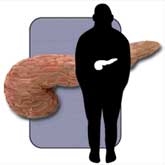The Human Pancreas
 The pancreas is a body organ that does some heavy lifting. It carries on two important functions relating to digestion and the regulation of blood sugar. The exocrine, the larger function, makes enzymes to help digest food such as proteins and fats. The exocrine portion releases these enzymes into the pancreas duct where it flows into the duodenum and mixes with food after it has left the stomach.
The pancreas is a body organ that does some heavy lifting. It carries on two important functions relating to digestion and the regulation of blood sugar. The exocrine, the larger function, makes enzymes to help digest food such as proteins and fats. The exocrine portion releases these enzymes into the pancreas duct where it flows into the duodenum and mixes with food after it has left the stomach.
The other function of the pancreas is called endocrine. It consists of scattered cells called islet cells which make hormones such as insulin and glucagon which regulate the body's blood sugar and hold it within a very tight range. If your blood sugar is too low, your brain won't function properly. If it is too high you would have diabetes which leads to damage to various body parts.
The pancreas is about the size of a small oblong loaf of bread. In humans, it is located in the back of the abdomen, behind the stomach and intestines, just above the belly button and against the spine. If affected by disease, the pancreas does not regenerate itself. If you lose more than 90% of your islet cells, you end up with diabetes. If you have chronic pancreatitis, an inflammation of the pancreas, you will have trouble with digestion and have to take enzyme pills. The pancreas works hard to process the food we eat.
About the Author
Carol Thomas, MD
 Dr. Carol Thomas is an Endocrinologist with a private practice in Palo Alto, California. Carol received her undergraduate degree at Stanford University and completed her medical residency at U.C.L.A. She is an Assistant Clinical Professor of Medicine at U.C.S.F. and has published numerous articles in her field of medicine. Dr. Thomas writes on endocrinology as well as general medical topics.
Dr. Carol Thomas is an Endocrinologist with a private practice in Palo Alto, California. Carol received her undergraduate degree at Stanford University and completed her medical residency at U.C.L.A. She is an Assistant Clinical Professor of Medicine at U.C.S.F. and has published numerous articles in her field of medicine. Dr. Thomas writes on endocrinology as well as general medical topics.


